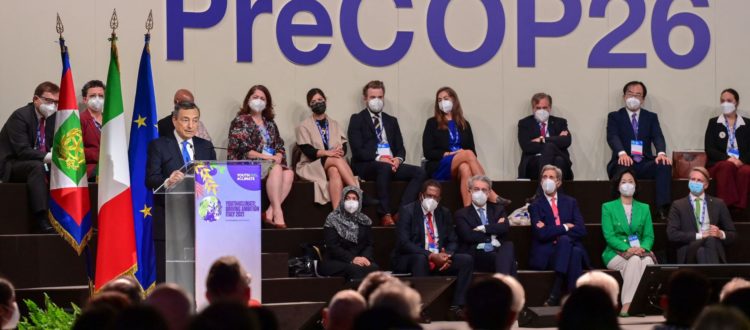PreCOP26: a constructive meeting, still too much coal in the room
by Jacopo Bencini, Policy Advisor and UNFCCC Contact Point

With the final press conference on Saturday 2 October, the preCOP in Milan – a ministerial-level preparation meeting ahead of COP26 in Glasgow – came to an end. For the attending Ministers and envoys this was the first in-person negotiation moment since Madrid 2019. The work began after having participated, on Thursday, in the restitution of the works of Youth4climate, the event organized by the Italian government to bring the voice of almost 400 young climate activists from all over the world in the negotiation process (we have talked about it in previous articles).
Ministers and envoys present in Milan worked by themes and subgroups. The most important session was perhaps the first, that of Thursday afternoon, on how to “keep alive” the goal of containing global warming by + 1.5 ° C, also in light of the first chapter of the new IPCC report (published on 9 August) and the report on NDCs published by UNFCCC in recent days.
Despite a generally constructive atmosphere in the rooms, as also confirmed by the statements at the press conference and by some insiders contacted by ICN, some issues to be resolved at a political level have emerged. If Western countries seem to have realigned themselves in terms of climate ambition with the return of the United States, also as a result of the climate summit organized by US President Joe Biden in April, the G7 and then the G20, China and Australia have taken different positions.
China, despite the recent announcement of a halt to any construction plan for new overseas coal plants at the UN General Assembly, remains essentially on the defensive of the return of the US global narrative – rebuilding the spirit of collaboration of 2015 after years of trade wars and geostrategic repositioning is today’s arduous task of the special envoy John Kerry, who, not surprisingly, in recent months has spent a lot of time in China in search of a dialogue with his counterpart. Australia, for its part, did not join the momentum expressed by the most ambitious countries on the exit from coal as a primary source of energy, in Milan as in previous months. The Australian position follows the results of the G7 in Cornwall, where last June the major global economies spoke firmly in favor of a rapid exit from the fossil source par excellence. The discussion in Milan echoed the one we saw during the G20 Environment in Naples on 23 July, when the first joint communication of the G20 on Climate and Energy of all time was published, after long negotiations, “incomplete” of two issues for the opposition from China, Russia and India: countries did not decide on the calendar for the global exit from coal, just as they did not decide on the stop to financing for unabated coal power generation plants and subsidies to fossil fuels. To understand why Australia was one of the most conservative players in preCOP26, it is sufficient to remember that to date its energy mix is still 76% composed of fossil fuels, of which 54% is energy produced from coal. An accelerated transition over the next ten years would involve mega-investments that the Canberra government does not seem willing to support to date.
The fact that even in that first working session on the two reports, IPCC and UNFCCC, insiders reported a collaborative and constructive atmosphere, could still be a good omen for Glasgow. In August, the first chapter of the new IPCC report highlighted the now near-impossibility of keeping temperatures within + 1.5 ° C as the minimum target of the Paris Agreement, with a planet that is already warmed up by an average of + 1.09 ° C today. The same report said that we will hardly be able to avoid reaching + 1.5 ° C by 2040. In recent days, the UNFCCC report on the ambition of NDCs sent another clear message: to date, despite the updated promises of many countries, we are far off track. Even if all countries fully respected what was promised in their national documents, including the measures indicated to date as conditional (i.e. dependent on external aid), we would still see a stabilization of the growth of emissions only around 2030, with the possibility of a emissions peak at 2030 only if all the conditional parts were implemented – that is, immediately supported by huge North-South flows in terms of finance, skills, knowledge. In short, according to current promises, the maximum we can expect for 2030 seems to be a stabilization of the growth of emissions or a peak, certainly not a decrease, in a context in which the goals set by the Paris Agreement would instead require a – rapid – decline of global emissions.

However, it is positive that the new NDCs presented in the second half of 2021, also following the climate summit organized by US President Joe Biden in April 2021, have already lowered the estimated growth of emissions by about 10% in 2030 compared to 1990 ( from + 70% to + 60%) compared to the pre-summit ones, in a context in which, however, as mentioned, global emissions continue to see (albeit moerate) growing figures – the new NDCs would in fact lead to emissions growth of “only” + 5% in 2030 compared to 2019, and no more + 11% as from previous estimates.
During preCOP26 in Milan, the US Special Envoy John Kerry hinted that before COP26 and during the conference some countries might communicate new goals and new, more ambitious NDCs. This underground work of American and Western climate diplomacy seems, as seen, to have already borne fruit and could perhaps revive hope towards COP26. Only and more than ever, politics, at this point, can reverse the trend and avoid what seems – and even more so since the release of the IPCC report in August – the announced failure of the minimum target of the Paris Agreement, keeping the global temperature within + 1.5 ° C.
You are reading this ICN COP Bulletin article is part of the EC DEAR SPARK project. ICN monitors negotiations and reports what is happening in Italian and English, on our website and on social channels, as part of a pan-European consortium of over 20 non-profit organizations committed to promoting climate awareness with particular attention to the role of young people and issues related to international cooperation and gender policies.


